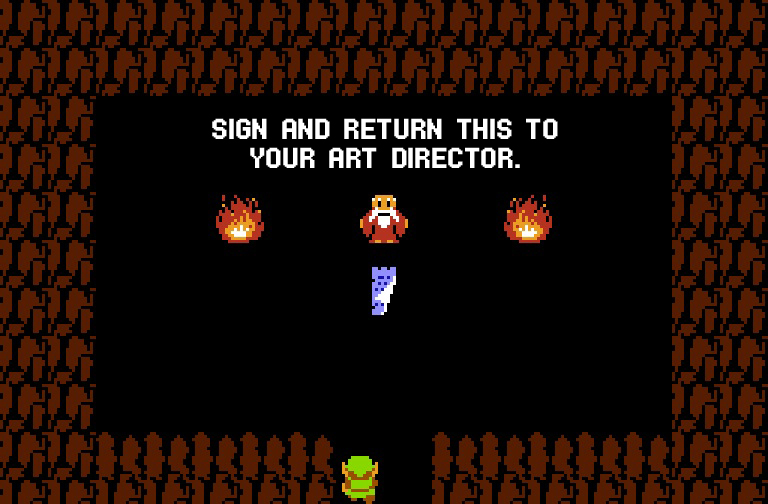So last post I started talking about what goes wrong with invoicing and accounting and all that, all the teeny little things that can add up to payments being delayed, missing, lost in transit, etc, when you are working with legit companies with proper accounting departments. Pretty much the moral of the story was: Generally people are not out to screw you over, things just get screwed up. And neither artists nor art directors are terribly good accountants generally, so we’re mostly self-taught, and we all make mistakes.
Well, let me tell you, artists and art directors are not trained to be lawyers either, yet contracts and legal terms, legalese, and fine print are very much a part of our business. For generations most artwork was commissioned with a gentleman’s agreement (and a martini if you’re watching Mad Men), but more and more companies are insisting on proper paperwork to get you paid. Also, issues of licensing and rights are changing rapidly with internet games, apps, and ebooks. And most artists are very happy to get work, so they generally sign a contract without looking it over too carefully (especially if it is coming from a legit company), and then find themselves complaining later about terms they unwittingly agreed to. Every company is different, and there’s a great deal of variance on things like territories, languages, kill fees, reproduction rights, etc. So I’m going to go thru some common terms and also some issues you should really be thinking about when you take on a job from a new company. Obviously, I’m going to be talking from a books centric view, but most of this is translatable.
1—JOB DESCRIPTION
Make sure a contract clearly states what the project is, how much you’re being paid for it, and when it is due. Generally a fill-in-the-blanks section. The more detail the better here.
2—REPRESENTATIONS
You are agreeing that this is your original work, and no part of it is under contract to anyone else. You are “representing” yourself as an artist available to hire (not under exclusive contract to anyone else) who does original work. Pretty much, this means if you’re found to have copied or stolen something later, the company is not responsible, you are.
Warning: If you use stock imagery, or any found imagery, in your work, you are responsible for making sure it is clear for use, and that you pass along the information to clear the art & pay the copyright holder along to the art director. Fonts too. There’s even tricky laws about using photos for reference too closely. Let us all remember the Shepard Fairey/Obama photo fiasco.
3—USAGE
Is the client paying you for one usage or all usages? For example, At Orbit we license for book use only. which means you retain the right to sell the same image for sneaker ads, album covers, to publish in a magazine, sell prints on your website, etc. If someone is buying all your rights to use the art for anything they want (called “Exclusive” Rights), and more importantly, keeping you from reselling the art for different usages, then they should be paying you more. Don’t forget merchandising rights too…just because I am buying rights for use on a book cover doesn’t mean I get to sell t-shirts with your art on it, even if its the whole book cover on the t-shirt.
Warning: “Work for Hire” means “Exclusive Rights” to the max. It means that you do not have the right to use the artwork you create for any purpose, even self-promotional. Although most companies will allow an artist to show work-for-hire work in their portfolios, unless it says so in the contract, you do not automatically have the legal right to. Most work done for well-known licenses (Disney, Star Wars, Tomb Raider, etc.) will be work-for-hire, because they can’t allow you to sell that work for any other purpose. Or show it to anyone without their say-so. License work is also usually protected by a Non-Disclosure Agreement “NDA”, which means you can’t show the work to anyone until the license makes it public.
5—TERRITORY/LANGUAGE
Art used to be licensed by physical territory – for example, before ebooks I always bought rights for just North America. However, with the internet and ebooks, where a product physically ships is less and less relevant, we are now licensing by language. So I am buying rights to not only use the art on a book cover, but only book covers in English, wherever they physically are. This is pretty standard now in books, apps, advertising – it’s called licensing “World English”. If a company wants all rights everywhere in every language, they call it “World” Rights. Or this may fall under the umbrella of “Exclusive Rights” – again, read the contract carefully.
This means that when a foreign publisher or company buys the rights to the book or product content, they need to relicense the art. If you’ve ever heard the term “sub rights” and not known what they do, this is it. We give the foreign publishers your contact information, and they are supposed to approach you to pay you to reuse it. Generally this is 50% of the original fee or less, but it depends on the country/language. It’s kind of a bluffing game, because you don’t want to quote a price so high that the publisher wants to scrap your art and make their own cheap ripoff.
Warning: Some countries are more well known for being shady (I’m looking at YOU, Poland) and will just take the files from the publisher and never contact the artist. Sometimes they’re even worse and they’ll swap art from one book to another. Sometimes they’ll literally buy the english edition, scan the cover, and photoshop off the text. Unfortunately it’s not the original company’s job to police that. Trust me, they’re stealing the content too, not just the art. I remember hearing about a foreign card game that just scanned and stole a bunch of Magic card art and reused it on their own card game. Good luck hunting them down, and even more luck getting them to pay you or change the cover.
6—REVISION RIGHTS
This is pretty much a clause saying the pesky Art Director can do whatever they want to your art after you hand it in – crop it wildly, change the colors, any revisions they want, and they do not need you to do it for them, and they do not need your permission. This is one that does tend to piss the crap out of artists, but look at it this way…no Art Director wants to make more work for themselves monkeying with your art. If they’re making revisions it’s to please someone who has the power to kill your artwork, and they’re trying to salvage it. Most of the time they’d be much happier (and I speak from experience) to leave it as you handed it in, but if recropping, or changing the color of something, will get the art approved, they will do as much as they can to keep from killing it.
7— KILL FEES
Many companies have kill fees (often 50% of the initial hiring fee) that you are given when you get partially thru the assignment and then it gets killed. Or even if the artwork is done, but for some reason doesn’t get used. However, a lot of companies can’t afford kill fees on top of the cost of restarting the art, and it needs to say so in the contract somewhere.
Warning: Make sure there is mention of a kill fee or what happens in the event a cover is killed. This might be one of the most frequent problems that pops up between artists and ADs. You can’t demand a kill fee if it’s not in the contract.
8—FUTURE RIGHTS
This is kind of a miscellaneous heading, and it’s kind of “What-If” terms. kind of “If this happens, then we have the right to do this, so long as we pay you.” Sometimes a company will say in the contract they have the option to use the art for different usages as long as they send you more money. This comes up in books a lot, because I will license for hardcover use, but in the contract it says I have the right to put the art on a second format (like paperback or audio) without needing to get your permission again, so long as I pay you X% of the original fee, or a flat money amount.
Artists rarely think this way, but remember, you’re not necessarily being paid to create the art, you’re being paid to license it’s usage. Think of it that way and you’ll automatically be a more savvy businessman.
So I’m sure I’m leaving some finer points out in my generalizing, so feel free to ask questions in the comments!








This is helpful, so was part 1, Thanks! Question: When the artist is reading through a contract and runs into a deal-breaker (for example, no mention of a kill fee) can the artist submit a request for a change to the contract before signing? Or is there usually no flexibility and the artist has to either sign it as-is or turn down the job?
Interesting stuff, I love these articles. Why the heck don't they teach this stuff in art school?!
It really depends. If something is MISSING In a contract and it needs to be clearer, then you can usually ask for it to be added in – most contracts have a notes section that you can write things in. For example I had an artist that wanted me to write in that he was absolutely still able to sell prints of the piece unrelated to the book, and it does imply that in the text of our contract, but he just felt better with it there, so I wrote it in.
As far as changing terms, like adding a kill fee if it's not company policy to do so, Art Directors have only so much wiggle room. Most times those policies are just company policy and there's a legal dept. insisting. However, there's usually a good reason, or at least an explainable reason, for every term in a contract, so you can absolutely ask questions. I ask questions of my legal dept all the time…
I have asked that many times. Some schools are better at it than others, but even the more real-world savvy ones, like SVA, don't have an official business of art class or anything like that, it's just that the teachers are encouraged to bring real-world issues into the classroom.
well actually, i know the SVA Design dept doesn't…maybe the Illo dept does…but I think it's still more up to the individual teachers to think it's important.
Thanks for these Lauren! Looking forward to more post from you. If they are going to be this informative it will be really helpful for new freelancers.
Absolutely wonderful. I try to bring business issues into the classroom but have to do it in general ways because every company and situation can be so different. I try to hit common issues and many of them are outlined here, Thanks Lauren.
Thanks for the great article! This is helpful information for all of us trying to make an honest living as an artist. Can you recommend any resources for example contracts?
you know, I'll ask my legal dept if they don't mind me posting ours as an example – if so i'll post it in part 3. I was planning on moving ahead to working with non-professionals, or really small companies and clients, when you're the one giving them contracts, and how to simultaneously educate them & protect yourself.
Thank You for this!
Often times, contracts sent out are written in legalese by people who are paid to do so… only to be handed over to those of us who struggle with legalese, trying to figure out what it all means.
It would be great to find some kind of “Business of Art” or “Contract Law For Artists” course somewhere.
Awesome Lauren! Thanks for your help 🙂
Thank you!
I whish I had this kind of information when I was starting out, green as grass and a foreigner on the US market to boot, it would have saved me a few headaches for sure.
Man, I love having you on the blog.
Thank you very much for this information.
Copyright talk by Josh Wattles , advisor-in-chief to deviantART and former general counsel for Paramount Pictures, speaking at Comic-Con 2012.
Fan Art Law at Comic-Con http://www.youtube.com/watch?v=xKBsTUjd910
I can't even tell you how much I appreciate your time and effort to spread this information out to us artists. It's shocking how little information is available and you have made it so easy for us to understand. Thank you thank you thank you thank you! Looking forward to post #3! -J
Thank you for taking the trouble to write these posts – really helpful!
Lauren,
Thank you so much for taking the time to write this! This is extremely helpful, especially for someone like me who is currently transitioning from in-house artist to freelancer.
I have a few interrelated questions, if you don't mind me asking:
-Are companies always responsible for handing out contracts?
-What is an instance where an artist needs to write up a contract himself?
-Is it possible at all to have 2 separate contracts from both parties (I probably know the answer to this one, but I thought I'd ask anyway)?
Thanks in advance!
<3
oh awesome, i'll check it out. i've been considering finding a lawyer to partner on a creative law/contracts class with me…
well i'm generalizing a lot in the service of passing on the gist…but remember to refer to expert accountants and lawyers and the irs for specific questions! haha.
—both parties should WANT a contract, for mutual protection, but generally it's the bigger party that gives the contract, so companies like mine that are commissioning a lot of art do generally have a standard contract that has been vetted or prepared by their legal dept, that covers all the things that the company needs to protect itself. However most ADs (GUILTY AS CHARGED) are chronically behind on their paperwork. You can always feel free to remind them to send over a contract.
—If a client doesn't give you a contract (common in startups and private persons) you should have a standard one that covers all the terms YOU need laid out for your own protection. I'm going to tackle this in Part 3. A contract to a nonprofessional asking you for work is half protection, half education of the client.
—Not really. One contract has to “win” – you can have 2 contracts – one has to be superior in case there are contradictory terms. The secondary contract can be included into the primary contract if there's a lot of extra terms in there not covered by the first, but there has to be some language in there that says which contract supersedes the other. so then, you're really just making one big contract.
Great. Thank you so much! I was just wondering when the right time to bring up the conversation of contracts if the client hasn't mentioned it yet, so this helps a lot! Thanks again!
usually once you settle on a price/deadline, then say, great, do you have a contract or do you want me to send you my standard contract.
Lauren, do you have any advice for artists looking to find a publishing company? How do you get your artists contracted?
Thank you so much for all this information!
As I am trying to make a living as an artist I get contacted by a lot of possible clients. And a lot, especially those from US never heard of copy/ use rights. In Germany at least its worded by the law that you HAVE to get paid for the right to use the picture.
Many clients think they just buy it like a T shirt and its done. not to mention that they are astonished by the cost of a good illustration+ total buy out.
Especially the fantasy genre is pretty poorly paid in general. At least thats my experience.
do you mean for freelance cover illustration, or do you mean to publish an art book of your work? as far as finding freelancers to work with, it's a little bit of everything…facebook, meeting people at conventions, blogs, other ADs or artists' recommendations, straight emails or mail promos…
I'm going to cover this in part 3, but honestly most people just need a little education in pricing. it's not that they're out to cheapen your work, they just have no experience in what art costs, or how much work goes into it. A little client education goes a very long way. I'm working on that post and will post it either next or the one after, so stay tuned.
I love the way you start and then conclude your thoughts. It's beautiful described dear. Thanks for sharing it
Developpement licensing & Qu’est ce que le licensing?
I read whole stuff. Very informative
Lizenzagentur & Lizenzprodukt(e)
I get all answer of my qestion that arise in my mind. Nice post dear. Territori sotto licenza & Agenzia di marchi sportivi
Great post full of useful tips! My site is fairly new and I am also having a hard time getting my readers to leave comments. Analytics shows they are coming to the site but I have a feeling “nobody wants to be first”.
Buy Facebook Likes
wow this good but ,I like your post and good pics may be any peoples not like because defrent mind all poeple ,
buy facebook likes cheap
I have a friend who went to SVA and when I (self-taught) complained about not knowing about the business end of art, he told me he didn't know any more than I did when he started out either, so probably not? But maybe it is different by now.
Cash for homes in Okotoks was a breeze. No realtor, no hassle, just quick results.
Looking for a reliable dry cleaner in London? Dry Cleaning Junction offers premium services to ensure your clothes receive the best care. Whether it’s everyday items or delicate fabrics, we’ve got your dry cleaning needs covered in London.
The Buy Verified Cashplus Account is a convenient solution for those needing a ready-to-use UK online banking account. Fully verified and activated, it’s ideal for managing finances, receiving payments, and handling everyday transactions without delays. Whether for business or personal use, this account offers fast setup, secure access, and full functionality. A great option if you want a hassle-free way to get started with Cashplus banking.
Great post, you have pointed out some superb points , I as well think this s a very wonderful website.
Vielen Dank für diese Tipps! Ich habe alle möglichen Suchmaschinen durchsucht, um sie zu finden!
I’m obsessed with TikTok Purple Ticket lately!
Earning free prizes and rewards has never been easier.
Try it for yourself here:
The law offices of SRIS PC provide guidance in areas like divorce, custody, and more. Contact the law offices of SRIS PC to learn how we can assist you today.
Legal matters involving family require careful handling. A Family Law Attorney Virginia can assist with divorce, custody, and related concerns.
Excellent .. Amazing .. I’ll bookmark your blog and take the feeds also…I’m happy to find so many useful info here in the post, we need work out more techniques in this regard, thanks for sharing.
I do believe all of the ideas you’ve offered to your post. They’re really convincing and will certainly work. Still, the posts are very brief for starters. May just you please lengthen them a little from next time? Thank you for the post.
Website Optimization… […]the time to read or visit the content or sites we have linked to below the[…]…
Thanks for sharing this great article! That is very interesting I love reading and I am always searching for informative information like this.